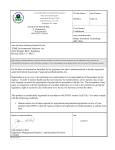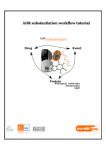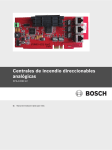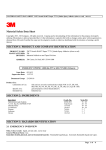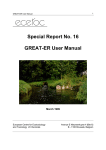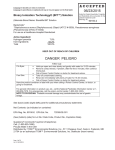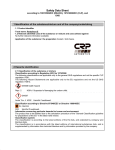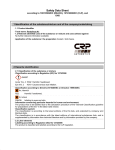Download View MSDS - KellySolutions.com
Transcript
Safety Data Sheet SECTION 1: IDENTIFICATION Trade Names: Binary Ionization Technology® BIT Binary Ionization Technology® BIT™ BIT™ Solution Ready-To-Use Hydrogen peroxide <8% SteraMist™ BIT™ Intended Use: For use as a Hospital-Healthcare Disinfectant and Mold Control and Mold Inhibitor during remediation dry, precleaned enclosures located in industrial, commercial and institutional settings (including production operations in pharmaceutical manufacturing including clean rooms, laboratories, animal research facilities, hotel rooms, offices, cruise ships, and recreational facilities). Use Binary Ionization Technology® (BIT™) Solution only with SteraMist™ Environment System or SteraMist™ Surface Unit fogging/misting equipment following detailed instructions provided in the SteraMist™ Binary Ionization Technology® (BIT™) User Manual. Details of the Supplier of the Safety Data Sheet This Safety Data Sheet has been updated in accordance with the Globally Harmonized System (GHS). Manufacturer/ Supplier: TOMI Environmental Solutions, Inc. 5111 Pegasus Court, Suite A Frederick, MD 21704 800.525.1698 | 310.275.2282 Emergency Telephone Numbers: CHEMTREC (US): 800. 424.9300 | 703.527.3887 POISON CONTROL: 800.222.1222 SECTION 2: HAZARD(S) IDENTIFICATION Hazard Classification: Signal Word: Hazard Statement: For solution – Class IV; Irritant if on skin / Class I; Danger if in eyes Warning/Danger Minimally irritating to the skin and mildly irritating to respiratory tract. May be harmful if swallowed. May cause irreversible eye damage. User must wear goggles. If mist gets into the eyes, flush eyes with fresh water and seek immediate medical treatment. Weak oxidizing agent that is stable under normal conditions. TOMI™ Environmental Solutions, Inc. | East Coast Office | 5111 Pegasus Court, Suite A | Frederick, MD 20009 800.525.1698 | www.tomiesinc.com Precautionary Statement(s): Hazards to Humans and Domestic Animals DANGER: Causes irreversible eye damage. Harmful if absorbed through skin. Do not get in eyes, or on clothing. Avoid contact with skin. Wear appropriate protective eyewear such as goggles, face shield, or safety glasses. Wash thoroughly with soap and water after handling and before eating, drinking, and chewing gum, using tobacco or using the toilet. Remove and wash contaminated clothing before reuse. GHS Label Elements: Irritant if on skin / Danger if in eyes Note: This document has been prepared in accordance with standards for workplace safety, which require the inclusion of all known hazards of the product or its ingredients regardless of the potential risk. The precautionary statements and warnings included may not apply in all cases. Your needs may vary depending upon the potential for exposure in your workplace. SECTION 3: COMPOSITION/INFORMATION ON INGREDIENTS Chemical Name CAS# Hydrogen peroxide EINECS <8 231-765-0 Xi, R36 Trade secret <4.5 Trade secret Xi, R36 7732-18-5 >87.5 231-791-2 7722-84-1 Inert Ingredients (trade secret) Water EU Classification/ EU Risk Phrases Weight % Not classified The Full Text for all EU Classification and EU Risk Phrases is Displayed in Section 16. In accordance with 29 CFR 1910.1200(i), the specific chemical identity and/or percentage of composition of certain ingredients are being withheld as a trade secret. SECTION 4: FIRST-AID MEASURES Eyes: o o o Hold eye open and rinse slowly and gently with water for 15-20 minutes. Remove contact lenses, if present, after the first 5 minutes, then continue rinsing eye. Call a Poison Control Center or doctor for treatment advice. Skin: o o o Take off contaminated clothing. Rinse skin immediately with plenty of water for 15-20 minutes. Call a Poison Control Center or doctor for treatment advice. Ingestion: o Rinse mouth with water. o Dilute by giving 1 or 2 glasses of water. Do not induce vomiting. o See a medical doctor immediately. Inhalation: TOMI™ Environmental Solutions, Inc. | East Coast Office | 5111 Pegasus Court, Suite A | Frederick, MD 20009 800.525.1698 | www.tomiesinc.com o o Remove to fresh air. Consult doctor in case of symptoms. Notes to Medical Doctor: o Direct contact may be minimally irritating. o Treatment is by dilution and is symptomatic and supportive. SECTION 5: FIRE FIGHTING MEASURES Suitable Extinguishing Media: Noncombustible - flood with water or agent suitable to environment. Fire Fighting Procedures: Any tank or container surrounded by fire should be flooded with water for cooling. Wear full protective clothing and self-contained breathing apparatus. SECTION 6: ACCIDENTAL RELEASE MEASURES Person-related Safety Precautions: Wear protective equipment. Keep unprotected persons away when applying. Measures for Environmental Protection: Do not allow product to reach sewage system or water bodies. Measures for Cleaning/Collecting: Absorb with liquid-binding material (sand, diatomite, acid binders, universal binders, sawdust) or wipe with towel. Additional Information: No dangerous materials are released. SECTION 7: HANDLING AND STORAGE This section provides guidance on the safe handling practices and conditions for safe storage of chemicals. The required information consists of: Handling o Information for safe handling: No special measures required. o Information about protection against explosions and fires: No special measures required. Storage o Requirements to be met by storerooms and containers: No special requirements. o Information about storage in one common storage facility: Store away from foodstuffs. o Further information about storage conditions: Do not store in direct sunlight. SECTION 8: EXPOSURE CONTROLS/PERSONAL PROTECTION Personal Protective Equipment (general) o General protective and hygienic measures: The usual precautionary measures for handling chemicals should be adhered to. o Breathing equipment: See below. o Protection of hands: See below. o Penetration time of glove material: The exact break through time will vary by manufacturer. Please refer to glove manufacturer data. o Eye protection: Safety glasses recommended during refilling. o Handling BIT™ Solution: long-sleeved shirt and long pants; socks and chemical resistant footwear; goggles safety or glasses with side shields, or face shield; chemical-resistant gloves such as barrier laminate, butyl rubber, nitrile, neoprene rubber, polyvinyl chloride, or Viton. o Handheld Unit Application: Where airborne hydrogen peroxide concentrations are expected to exceed 1 ppm, air-purifying respirator with a full-face piece or hood in TOMI™ Environmental Solutions, Inc. | East Coast Office | 5111 Pegasus Court, Suite A | Frederick, MD 20009 800.525.1698 | www.tomiesinc.com combination with an air- purifying cartridge recommended by the manufacturer specifically for hydrogen peroxide use. Exposure Limits/ Components with Limit Values that Require Monitoring at the Workplace Chemical Name Hydrogen peroxide TLV (ACGIH) 1 ppm STEL/Ceiling (ACGIH) N/A PEL (OSHA) STEL/Ceiling (OSHA) 1 ppm SECTION 9: PHYSICAL AND CHEMICAL PROPERTIES MIXTURE (the following mixture data are for 5% Hydrogen Peroxide): Appearance: Clear, colorless liquid Odor: Odorless pH: 7.0 to 8.0 Freezing Point: -3°C (27°F) Boiling Point: 101°C (214°F) Flash Point and Method: Noncombustible Flammable Limits: Noncombustible Fire/Explosion Hazards: Product is non-combustible. On decomposition releases oxygen which may intensify fire. Vapor Pressure: 31 mm Hg @ 30°C (86°F) Vapor Density: No data available Solubility in Water: 100% Evaporation Rate: > 1 (Butyl acetate = 1) Specific Gravity: 1.01 @ 20°C (68°F) (H2O = 1) % Volatile: 100% Auto-ignition Temperature: Noncombustible Hazardous Decomposition Products: Oxygen, which supports combustion Sensitivity to Static Discharge: No data available Sensitivity to Impact: No data available HYDROGEN PEROXIDE: Molecular Formula: H2-O2 Molecular Weight: 34.01 g/mole pH: Weak acid; H2O2 concentration weight % = 35, 50, 70, 90; corresponding true pH: 4.6, 4.3, 4.4, 5.1 Specific Gravity: 1.4425 @ 25°C (77°F) Melting Point: -0.43°C (31°F) Boiling Point: 152°C (305.5°F) Vapor Pressure: 1.97 mm Hg @ 25°C (77°F) Solubility: Miscible with water; soluble in ether; insoluble in petroleum ether, soluble in alcohol. Viscosity: 1.245 cP (liquid) SECTION 10: STABILITY AND REACTIVITY Thermal decomposition/ conditions to be avoided: TOMI™ Environmental Solutions, Inc. | East Coast Office | 5111 Pegasus Court, Suite A | Frederick, MD 20009 800.525.1698 | www.tomiesinc.com N/A o No decomposition if used and stored according tospecifications. Dangerous products of decomposition: Possible in traces. SECTION 11: TOXICOLOGICAL INFORMATION MIXTURE (the following mixture data are for Binary Ionization Technology® (BIT™) Solution: Eye Effects: Corrosive irritant (rabbit) Skin Effects: Mild or slightly irritating after 14 days (rabbit); No perceptible reaction (guinea pig) Dermal LD50: > 2,000 mg/kg (rabbit) Oral LD50: > 5,000 mg/kg (rat) Inhalation LC50: > 2.77 mg/L (rat) HYDROGEN PEROXIDE: Eye Effects: 5% hydrogen peroxide: Minimally irritating (rabbit) [FMC Study Number: I86-0949] Skin Effects: 10% hydrogen peroxide: Mildly irritating after 4-hour exposure (rabbit) [FMC Study Number: I89-1078] Dermal LD50: 35% hydrogen peroxide: > 2,000 mg/kg (rabbit) [FMC Study Number: I83-746] Oral LD50: 10% hydrogen peroxide: > 5,000 mg/kg (rat) [FMC Study Number: I89-1077] Inhalation LC50: 50% hydrogen peroxide: > 0.17 mg/L (rat) [FMC Study Number:I89-1080] Acute Effects from Overexposure: Minimally irritating to the eyes, skin, nose, throat, and lungs. Chronic Effects from Overexposure: The International Agency for Research on Cancer (IARC) has concluded that there is inadequate evidence for carcinogenicity of hydrogen peroxide in humans, but limited evidence in experimental animals (Group 3 - not classifiable as to its carcinogenicity to humans). The American Conference of Governmental Industrial Hygienists (ACGIH) has concluded that hydrogen peroxide is a ’Confirmed Animal Carcinogen with Unknown Relevance to Humans’ (A3). Carcinogenicity: ACGIH Listed (A3, Animal carcinogen) SECTION 12: ECOLOGICAL INFORMATION (NON-MANDATORY) ECOTOXICOLOGICAL INFORMATION (Data from toxicity tests - 7722-84-1 hydrogen peroxide solution): Channel catfish 96-hour LC50 = 37.4 mg/L Fathead minnow 96-hour LC50 = 16.4 mg/L Daphnia magna 24-hour EC50 = 7.7 mg/L Daphnia pulex 48-hour LC50 = 2.4 mg/L Freshwater snail 96-hour LC50 = 17.7 mg/L For more information refer to ECETOC "Joint Assessment of Commodity Chemicals No. 22, Hydrogen Peroxide." ISSN-0773-6339, January 1993 CHEMICAL FATE INFORMATION: Hydrogen peroxide in the aquatic environment is subject to various reduction or oxidation processes and decomposes into water and oxygen. Degrades in the atmosphere within the light spectrum with hydroxyl radicals in the gas phase and subsequent photolysis. SECTION 13: DISPOSAL CONSIDERATIONS (NON-MANDATORY) Product: Recommendation: Smaller quantities can be disposed with household garbage. Uncleanedpackaging: Recommendation: Disposal must be made in accordance with applicable local regulations. Recommended cleaning agent: Water TOMI™ Environmental Solutions, Inc. | East Coast Office | 5111 Pegasus Court, Suite A | Frederick, MD 20009 800.525.1698 | www.tomiesinc.com SECTION 14: TRANSPORT INFORMATION (NON-MANDATORY) The following refers to all modes of transportation unless specified below. Not regulated for transport under USDOT, EUADR, IATA, ICAO, or IMDG regulations. SECTION 15: REGULATORY INFORMATION (NON-MANDATORY) OSHA Label: Non-hazardous in accordance with international standards for workplace safety. SECTION 16: OTHER INFORMATION Text of classification and phrases referred to under heading 3: R36: Irritating to eyes. R67: Vapors may cause drowsiness and dizziness. Xi: Irritant. HMIS = Hazardous Materials Identification System (During Application) Health 0 = Minimal Flammability 0 = Minimal Physical Hazard 0 = Minimal Personal Protection (PPE) H Protection = H (Safety goggles, gloves, apron, the use of a supplied air or SCBA respirator is required in lieu of a vapor cartridgerespirator) NFPA = National Fire Protection Association (During Application) Health 0 = Insignificant Flammability 0 = Insignificant Reactivity 0 = Insignificant Special None No specialrequirements Revision Summary: This SDS was generated July 2014. The above data are based on our present knowledge. However, they shall not constitute a guarantee for any specific product features and shall not establish a legally valid contractual relationship. TOMI Environmental, Inc. believes that the information contained in this Safety Data Sheet is accurate, and, while it is provided in good faith, it is without a warranty of any kind, expressed or implied. Disclaimer: The contents of this MSDS are believed to be correct but do not purport to be all-inclusive and should only be used as a guide. TOMI Environmental Solutions, Inc. disclaims any express or implied warranty as to the accuracy of the above information and shall not be held liable for any direct, incidental or consequential damages resulting from the reliance on the above information. TOMI™ Environmental Solutions, Inc. | East Coast Office | 5111 Pegasus Court, Suite A | Frederick, MD 20009 800.525.1698 | www.tomiesinc.com






